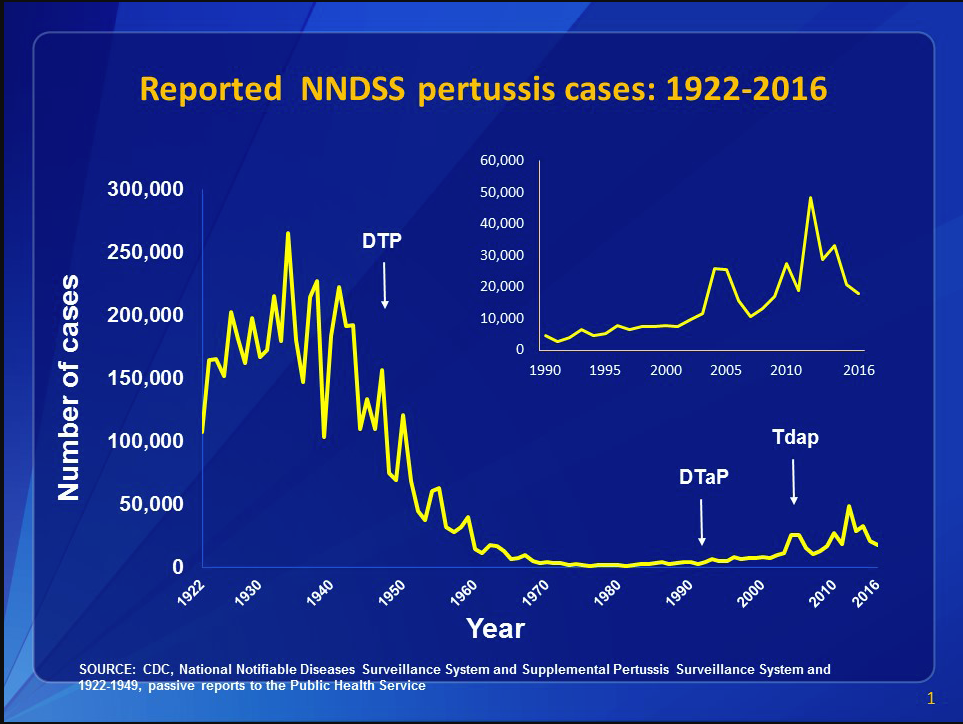Pertussis Vaccine Administered After 1995 Induces Weaker Recall Immune Response
A new study observed that the type of pertussis vaccine used to prime the immune system in childhood has a lasting effect on an individual’s future immune response.
Since the 1980s, cases of pertussis (whooping cough) have been increasing in the United States (see graph). Despite the availability of a vaccine, there were still 15,808 cases of pertussis in the United States in 2017. According to an international team of investigators, the reason for these high rates may lie in the formulation of the current vaccine. Specifically, they suggest that individuals vaccinated with the newer acellular pertussis (aP) vaccines mount a weaker recall response to pertussis when receiving booster shots.

Source: https://www.cdc.gov/pertussis/images/incidence-graph.png
In 1996, aP vaccines were universally adopted in the United States to replace the old whole-cellular pertussis (wP) vaccines after they were deemed to have a better safety profile. The newer vaccine proved to be effective at preventing pertussis in the vulnerable stages of life; however, an increase in cases of pertussis in the United States since its introduction, and among the population who received it prompted researchers to look into the immune recall responses elicited from the aP vaccine (DTaP) and the older wP vaccine (DTwP).
For the study, published in the Journal of Clinical Investigation, investigators from the United States and the United Kingdom recruited 114 adult participants from the San Diego, California area who had adhered to the recommended vaccination regimen for pertussis. Participants who had been diagnosed with Bordetella pertussis infection at any point during their lives, as well as participants who were pregnant, had a severe disease or were undergoing medical treatment that would interfere with the study, or who had received a vaccine, were on antibiotics, or who had a fever greater than 100.4°F, were excluded from the study.
Remaining participants were administered Tdap booster vaccinations regardless of if they received the wP vaccine or the aP. Blood samples were then taken 1, 2, 3, or > 4 months following the booster. The investigators examined the samples for pertussis-specific memory CD4+ T cell responses ex vivo, highlighting a Type 2/Th2 versus Type 1/Th1 and Th17 differential polarization as a function of childhood vaccination.
The results indicated immunological differences between the 2 groups. Participants who had received the wP vaccine during childhood produced IFNY/IL-17 polarization, IgG1 increase, T cell boost, and high proliferation in ex vivo responses. In comparison, the aP primed participants, showed IL-4/IL-9 polarization, IgG1/IgG4 increase, no T cell boost, and lower proliferation.
“We see a dramatic imprinting effect depending on whether people received the old or the new pertussis vaccine as part of their original childhood immunizations,” said Alessandro Sette, PhD, professor, center head, Division of Vaccine Discovery at La Jolla Institute for Allergy and Immunology, and the study’s senior author in a statement. “Even if the booster shots they received as middle and high schoolers or as adults contained the same vaccine, the immune system still has a very striking recollection of what it saw during the first immunization.”
The investigators found that the aP vaccine fell short of generating a robust T cell response, which is responsible for providing long-term memory that permits the immune system to mount a rapid response in exposure to the pathogen. The study authors stated that overall, for donors originally vaccinated with wP, responses were boosted by approximately 2.5-fold. In the case of the donors vaccinated with the aP vaccine, no significant booster effect was noted at the level of T cell responses.
“Ideally, you should engage both arms of a protective response against pathogens—B cells that produce antibodies and T cells that generate long-term memory,” said first author Ricardo Antunes, PhD, a postdoctoral researcher in Sette’s lab in the statement. “But apparently the new vaccine fails to generate an adequate T cell response.”
"Since we can see clear differences in the immune signatures induced by the 2 different vaccines within days of a booster, this suggests that a potential path forward would be to test if new vaccines might be able to reproduce the more protective signature," concluded Dr. Sette.
